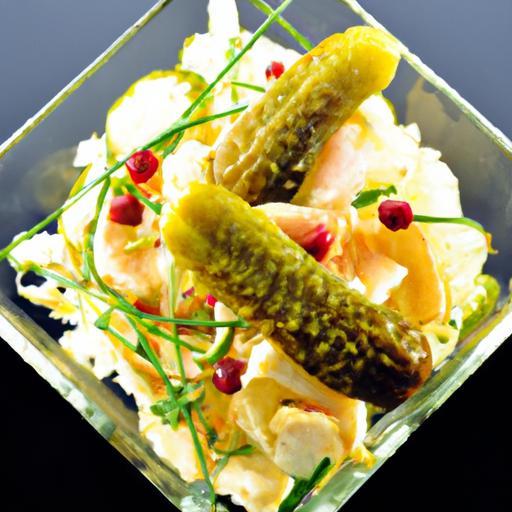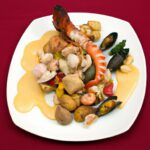In the vibrant world of flavors, few culinary processes can match the enchanting allure of a tangy twist. Fermentation and pickling-two age-old techniques steeped in history-have long been the secret wizards behind the zesty notes that dance on our taste buds. While they may seem like close cousins in the kitchen, each method carries its own unique magic, transforming humble vegetables, fruits, and even proteins into delicious, shelf-stable delights. Join us as we unravel the mysteries behind fermentation and pickling, exploring how these time-honored traditions shape the textures, flavors, and nutritional stories of some of our favorite tangy treats. Whether you’re a food enthusiast or simply curious about what makes that sour snap so irresistibly good, this deep dive will leave you savoring the science-and the art-behind food’s tangy twist.
Fermentation vs Pickling unveils a fascinating world where microbes and acids orchestrate the magic of tangy flavors, elevating everyday food into vibrant culinary treasures. When you bite into a crunchy cucumber or sip on a rich kombucha, you’re tasting centuries of microbial craftsmanship and chemical alchemy that not only preserves but transforms food’s essence. Understanding the science behind these ancient techniques empowers your cooking and inspires creativity in your kitchen.
Prep and Cook Time
Preparation: 15 minutes (active) + fermentation time varies
Pickling: 10 minutes (active) + at least 24 hours marinating
Yield
Approximately 4 cups of tangy goodness, perfect for serving 6 people as a side or condiment.
Difficulty Level
Medium – Requires minimal equipment and patience but yields transformational flavors.
Ingredients
- 4 cups fresh cucumbers, assorted sizes, sliced into spears or rounds
- 2 tbsp sea salt, non-iodized for fermentation
- 3 cups filtered water, for brine
- 2 cups distilled white vinegar, for quick pickling
- 1 tbsp sugar, optional, enhances fermentation balance
- 4 cloves garlic, smashed
- 1 tbsp whole black peppercorns
- Fresh dill sprigs, about 6 sprigs
- Optional spices: mustard seeds, coriander seeds, or chili flakes
Instructions
- Prepare the cucumbers: Rinse and slice cucumbers to your preferred thickness; firm spears for crunch or rounds for snacking ease.
- Make the fermented brine: Dissolve 2 tbsp sea salt in 3 cups filtered water. This creates an anaerobic environment perfect for lactobacillus growth, the powerhouse behind fermentation tang.
- Pack your jar for fermentation: Place the smashed garlic, peppercorns, dill, and optional spices inside a large glass jar. Add cucumbers snugly but not too tightly to allow brine flow.
- Cover with brine: Pour the salted water brine over the cucumbers until completely submerged. Use a weight or clean small jar to keep cucumbers under the liquid-essential to prevent mold and ensure consistent fermentation.
- Seal and wait: Close the jar with a fermentation lid or loose lid to let gases escape. Keep the jar at room temperature away from direct sunlight for 5-7 days. Taste daily after day 3 to catch your desired tang level. The signature sour notes emerge from microbial metabolism transforming sugars into lactic acid.
- For quick pickles: In a saucepan, combine 2 cups vinegar, 1 tbsp sugar, and 1 tbsp salt. Bring to a simmer until sugar dissolves. Pour boiling brine over cucumbers packed with garlic, peppercorns, dill, and optional spices in a separate jar.
- Cool and refrigerate: Seal pickling jars tightly and chill at least 24 hours before tasting. The acidity from vinegar instantly arrests microbial activity, creating a crisp, tangy profile distinct from fermentation.
- Store and enjoy: Fermented pickles improve in flavor over weeks; quick pickles are best consumed within 2 weeks for peak crunch and zest.
Tips for Success
- Use filtered water to avoid chlorine interfering with fermentation microbes.
- Maintain a clean workspace and sterilized jars to prevent contamination and unwanted mold.
- If fermentation brine appears cloudy or bubbly, it’s a good sign of active microbes-trust your nose for any off smells.
- Adjust salt level to taste but 2% salt by weight ensures safe preservation during fermentation.
- For vibrant pickled vegetables, use vinegar-based quick pickling to retain snap and color.
- Experiment with mixed vegetables like carrots or radishes for layered flavor complexity.
Serving Suggestions
Present your tangy cucumbers in a rustic wooden bowl garnished with fresh dill and a sprinkle of chili flakes for visual pop and a spicy kick. Fermented varieties shine atop creamy avocado toast or alongside smoky barbecue, where their probiotic crunch cuts through richness. Quick pickles add a sharp contrast to sandwiches and cheese boards – their vivid color alone brightens any platter.
| Nutrient | Per 100g | Notes |
|---|---|---|
| Calories | 15 | Low-calorie, ideal for snacking |
| Protein | 0.7g | Minimal, from cucumbers |
| Carbohydrates | 3.0g | Includes natural sugars for fermentation |
| Fat | 0.1g | Negligible |
Explore further how different preservation techniques impact your kitchen creations. For deeper scientific insight, the National Institutes of Health provides extensive research on lactic acid fermentation and its health benefits.

Q&A
Q&A: Fermentation vs Pickling – Unraveling Food’s Tangy Twist
Q1: What’s the big difference between fermentation and pickling?
A1: Think of fermentation as a lively party hosted by friendly microbes-bacteria and yeasts-that munch on sugars, producing tangy acids, bubbles, and probiotics. Pickling, on the other hand, is more like a preservation technique where food takes a soak in an acidic bath (usually vinegar) or salty brine to gain flavor and stay fresh. Fermentation creates flavor through microbial magic, while pickling often relies on added acid.
Q2: Can pickling be fermented, or are they mutually exclusive?
A2: They’re not sworn enemies; in fact, they can be best friends. Many traditional pickles start their journey as fermented foods-cucumbers brine with salt alone, letting wild bacteria impart complex flavors. Later, vinegar might be added for extra tang or preservation. So, while all fermented pickles are pickled, not all pickled foods are fermented.
Q3: How do the flavors differ between fermented and pickled foods?
A3: Fermented foods burst with depth-think earthy, funky, and effervescent notes from natural bacteria doing their thing. Pickled foods tend to boast a sharper, more straightforward zing from vinegar’s bright bite. Fermentation offers complex, evolving layers of flavor, while pickling delivers an immediate and punchy tang.
Q4: Which method is healthier-fermentation or pickling?
A4: Fermentation is often crowned the health hero because it produces beneficial probiotics-friendly bacteria that support gut health and digestion. Pickled foods, especially those made with vinegar, still carry antioxidants and vitamins but usually lack live cultures, as vinegar’s acidity can stop microbial growth.
Q5: Can I pickle or ferment any type of food?
A5: Almost! Fermentation loves veggies with natural sugars and starches-think cabbage, cucumbers, carrots, and even fruits. It’s more of a living process that needs the right environment and time. Pickling is more flexible, accommodating a broader range-eggs, meats, and even cheeses can join the vinegary soak party, often requiring less time.
Q6: How does texture change during fermentation vs pickling?
A6: Fermentation often softens vegetables gently while adding a pleasantly crisp snap, thanks to probiotic action and salt. Pickled foods can get crisp or soggy depending on acid concentration and time-the vinegar can firm up some foods or soften others quickly.
Q7: Why do some pickles taste fizzy?
A7: Fizz signals fermentation! Those bubbles come from carbon dioxide produced by microbes working away inside the brine. If pickles are fizzy, it means they’re alive and well with natural fermentation happening. Vinegar-only pickles usually stay flat-no microbial party there.
Q8: Which method is easier for a kitchen newbie?
A8: Pickling tends to be the beginner’s playground-quick, controlled, and less prone to surprises. Fermentation is a bit more of an art that demands patience and attention to hygiene and time, but the payoff is a living, probiotic-rich food with complex flavors.
Q9: Can fermentation or pickling preserve food for long periods?
A9: Both do a stellar job! Fermentation creates natural acids and alcohols that inhibit spoilage over time. Pickling uses acid and salt to create an inhospitable environment for harmful microbes. Properly stored, both can extend your goodies for months or even years.
Q10: How do cultural traditions influence fermentation and pickling?
A10: Around the globe, fermentation and pickling are culinary storytellers. Koreans savor kimchi (fermented veggies), Germans cherish sauerkraut, and Indians enjoy achars (pickled spices and fruits). Each culture brings its own twist, microbes, spices, and rituals, enriching the world’s tangy tapestry.
Now that you know the difference, the next tangy adventure in your kitchen awaits-will you invite the microscopic party of fermentation or dive into the sharp soak of pickling? Either way, your taste buds are in for a delicious twist!
Future Outlook
As we close the jar on our tangy exploration of fermentation and pickling, it’s clear that both methods offer more than just a puckering punch to our plates-they are living traditions that transform simple ingredients into flavors packed with history, culture, and science. Whether it’s the bubbling alchemy of fermentation or the crisp snap of pickling’s acidic embrace, each technique invites us to savor food in a new dimension. So next time you reach for that jar of tangy goodness, remember: behind every bite lies a fascinating journey of transformation, patiently crafted by time, culture, and microbial magic. Embrace the twist, and let your taste buds dance on this flavorful frontier.


